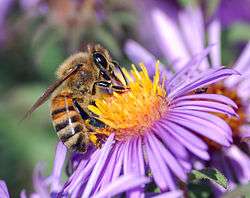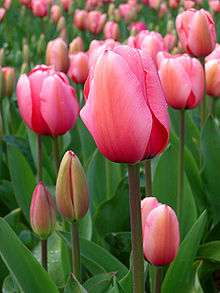Anthecology

Anthecology, or pollination biology, is the study of pollination as well as the relationships between flowers and their pollinators.[1] Most flowering plants, or angiosperms, are pollinated by animals, and especially by insects.[2] The major flower-frequenting insect taxa include beetles, flies, wasps, bees, ants, thrips, butterflies, and moths. Insects carry out pollination when visiting flowers to obtain nectar or pollen, to prey on other species, or when pseudo-copulating with insect-mimicking flowers such as orchids.[3] Pollination-related interactions between plants and insects are considered mutualistic,[4] and the relationships between plants and their pollinators have likely led to increased diversity of both angiosperms and the animals that pollinate them.[5]
Anthecology brings together many disciplines, such as botany, horticulture, entomology, and ecology.
History

Anthecology began as a descriptive science relying on observation, and more recently has come to rely upon quantitative and experimental studies.[6]
By the 17th century, the sexual nature of plant reproduction was recognized following the work of Nehemiah Grew and the experiments of Rudolf Jakob Camerarius, who showed that pistillate plants need both male and female organs for reproduction. Tulips and maize were popular subjects of study during this time. In 1735, Carl Linnaeus developed a "sexual system" of the classification of seed plants. In the mid-to-late 18th century, Joseph Gottlieb Kölreuter demonstrated that pollen must be transferred from stamen to stigma for reproduction to occur, and also clarified the distinction between nectar and honey.[7]
In the late 18th century, Christian Konrad Sprengel showed evidence that flowers attract insects and reward them with nectar. Following the emergence of the Darwinian theory of evolution in the late 19th century, scientists became keen to the selective advantage of cross-pollination. In an 1873 book, Hermann Müller made detailed observations of the particular relationships between certain insects and certain flowering plants, called pollination syndromes, and additional comprehensive surveys were made by Paul Knuth.
Anethecology went into decline for several decades, but the field was kept alive by several studies including those of honey bees by Karl von Frisch in the mid 20th century.[8]
Anthecology gained a resurgence in the 20th century during the rise of neo-Darwinism. Specific plant-insect interactions were further documented, with an emphasis on tropical anthecology, comparative anthecology, and co-evolution.[9]
Today, the biology of pollination has attracted the attention of scientists, governments,[10][11] and the media, following observations of rapid pollinator decline in the late 20th century, including the unexplained and sudden disappearance of honey bees in a phenomenon known as colony collapse disorder.
References
- ↑ Baker, Herbert G (1983). "An Outline of the History of Anthecology, or Pollination Biology". In Leslie Real. Pollination Biology. Academic Press. p. 8.
- ↑ Gullan PJ, Cranston PS (2005). The Insects: An Outline of Entomology (3rd ed.). Blackwell Publishing. p. 281. ISBN 1-4051-1113-5.
- ↑ Gullan PJ, Cranston PS (2005). The Insects: An Outline of Entomology (3rd ed.). Blackwell Publishing. p. 282. ISBN 1-4051-1113-5.
- ↑ Gullan PJ, Cranston PS (2005). The Insects: An Outline of Entomology (3rd ed.). Blackwell Publishing. p. 283. ISBN 1-4051-1113-5.
- ↑ Campbell NA, Reece JB (2005). Biology (7th ed.). Pearson Benjamin Cummings. p. 604. ISBN 0-8053-7146-X.
- ↑ Baker, Herbert G (1983). "An Outline of the History of Anthecology, or Pollination Biology". In Leslie Real. Pollination Biology. Academic Press. p. 8.
- ↑ Baker, Herbert G (1983). "An Outline of the History of Anthecology, or Pollination Biology". In Leslie Real. Pollination Biology. Academic Press. pp. 9–14.
- ↑ Baker, Herbert G (1983). "An Outline of the History of Anthecology, or Pollination Biology". In Leslie Real. Pollination Biology. Academic Press. pp. 9–14.
- ↑ Baker, Herbert G (1983). "An Outline of the History of Anthecology, or Pollination Biology". In Leslie Real. Pollination Biology. Academic Press. pp. 15–22.
- ↑ Warner, Bernhard (19 February 2013). "To Revive Honey Bees, Europe Proposes a Pesticide Ban". Bloomberg BusinessWeek. Retrieved 6 March 2013.
- ↑ "Blumenauer Announces Legislation to Protect Pollinators, Prevent Mass Bee Die-Offs". Blumenauer.house.gov. United States House of Representatives. Retrieved 27 August 2013.